LinkedIn is often seen as a platform for job seekers and business professionals to connect with others in their industry. However, it can also be a powerful tool for sales prospecting.
With a well-crafted LinkedIn profile, you can make a great impression on potential clients and increase your chances of landing new business opportunities.
LinkedIn Summary page is the most essential section, but it is often the most overlooked on users’ profiles. It is a few paragraphs long and is one of the first things visitors see on your profile.
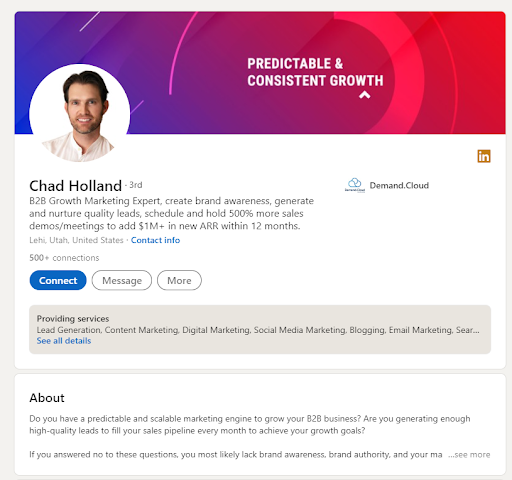
According to research by Rain Group, 82% of buyers research providers on LinkedIn before responding to a cold outreach message.
The About section on your LinkedIn profile is an important part of your online persona and allows others to learn more about who you are and what you’re passionate about. It’s a great place to introduce yourself, explain what drives you professionally, and show how you can help someone else.
This is the only section of the website where you can share your personality and connect with your prospects on a deeper level. Plus, this is the place where you can trigger leads to take the kind of action you want them to.
In this blog post, we’ll show you how to create a LinkedIn summary that will help you stand out from the competition.
1. Make your readers hit “see more”
Once a user opens your profile, they’ll be able to see the first 300 characters of your summary. Make sure to hook them enough to read more about you in full.
Keep in mind to personalize your approach and focus on building authentic connections. The goal is to give them a reason to engage with you.
Example:

2. Tell us who you are and provide your main goals
If you want to increase your current client base, you have to tell us who you are and list down your main goals. It will help you understand what you need to concentrate on in presenting yourself to your prospects.
Quick Tip: Start writing your summary in the first-person point of view, and don’t be afraid to inject some character.
Example:

3. Share what inspires you and explain why
Show your prospects what you are passionate about and why you love your job to build a relationship and be more trustworthy. Include reasons why prospects should choose your company. Do it subtly.
Quick Tip: To improve your LinkedIn ranking, add keywords that are relevant to your industry.
Example:

4. Give brief information about your job experience and describe your accomplishments
Giving examples of your successes will help you establish expertise and convince potential customers that you are a reliable source. Include, if possible, your success’s validated metrics.
Quick Tip:Describe your professional background and pinnacle achievements. Focus on the pain points of the prospect, and list the typical problems you have solved. Describe the prospects and their goals in your summary. and provide facts, awards, and/or metrics about your accomplishments.
Example
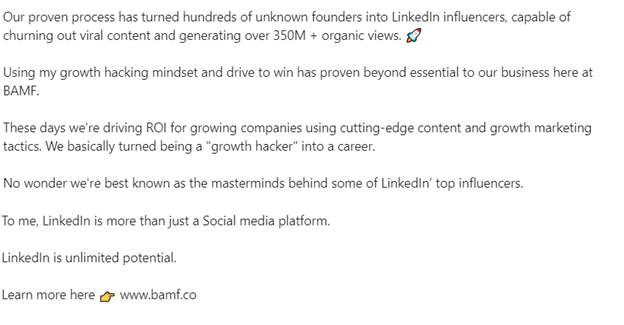
5. Educate your prospects on how your product/service can help them reach their goal
Do what you do best as a salesperson and demonstrate to your prospects the advantages of doing business with you, using the product or service, and how it can benefit them. Avoid being overly pushy, though.
Quick Tip: Organize the content into brief paragraphs and bullet points, highlight text with bold or italics, use emojis, and include your contact information and a CTA at the end.
Example:

Now that we’re done with the 5 steps, let’s check the excellent LinkedIn summary examples.
5 Excellent LinkedIn Summary Examples for Sales
Here are the top five LinkedIn summary examples for sales representatives or SDRs that you can use as examples when writing your own.
We’ll outline the various types of summaries while highlighting the key ideas from the previous checklist that they used.
1. Show your personality
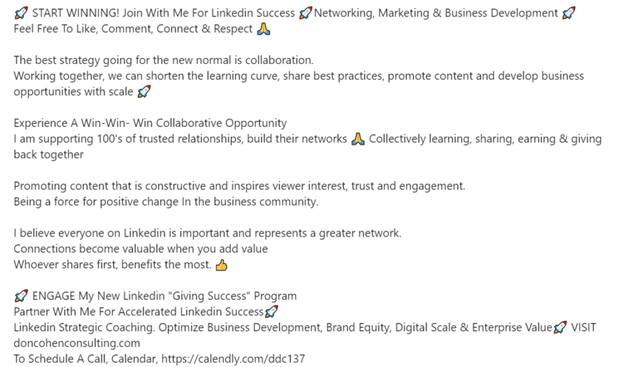
The perky personality and willingness to help and inspire others in this paragraph make it easy for the reader to connect with the author. The example also demonstrates how collaboration and building trustworthy relationships are important to the author.
The technical aspects of the article are strong, with a promising hook statement that immediately catches the reader’s attention. Additionally, they include several key keywords which can help it rank higher in search engines.
Steps and Tips Applied:
- an added personality;
- a hook statement;
- an added Keywords;
- the value offered to the prospect;
- Metrics about accomplishments included;
- CTA and website included.

2. Display Achievements to Gain Credibility
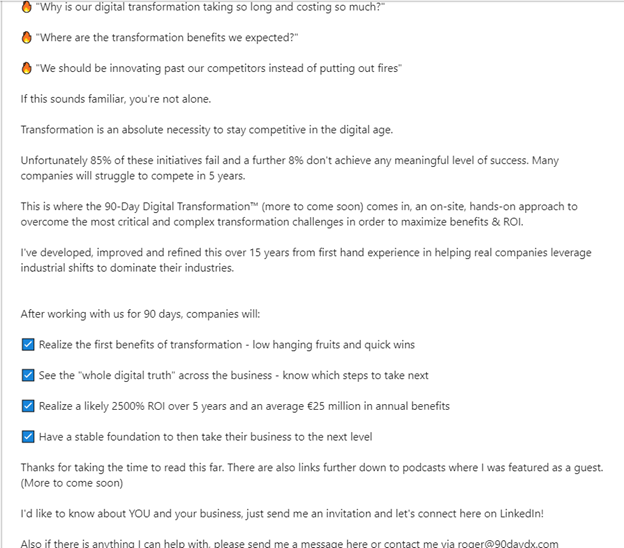
If you are trying to attract new customers, starting with questions that your target audience wishes to know can be a great way to get them interested. This example is result-oriented and will help jumpstart a conversation about what your services or products can offer.
Showing off your business results and collaborations can help increase conversions and get a lot of sales. This is especially true if you include a real proof.
Steps and Tips Applied:
- a hook statement that asks a question;
- the value offered to the prospect;
- added contact information;
- Added by CTA
- using emojis as bullet points;
- short paragraphs of text for easier reading and comprehension;
- a brief summary of the reader.
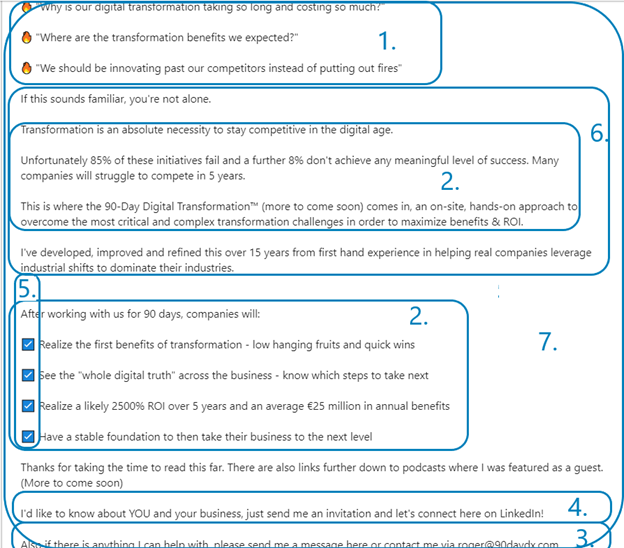
3. Sincere, Short and Niche-Focused
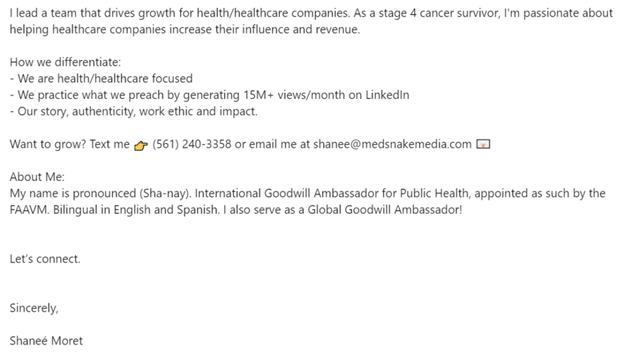
If you want to increase your chances of converting visitors to leads on LinkedIn, make sure your summary is concise and easy to read. This example can help you achieve that goal.
To create a memorable company profile, it is important to include personal history, the reason behind the company, and go straight to the point.
Steps and Tips Applied:
- offered the prospect value;
- additional personality
- added context for the career;
- metrics pertaining to successes;
- CTA comprised;
- Included is contact information;
- minimal use of bullet points and emojis;
- Small paragraphs in the text to make it easier to read.
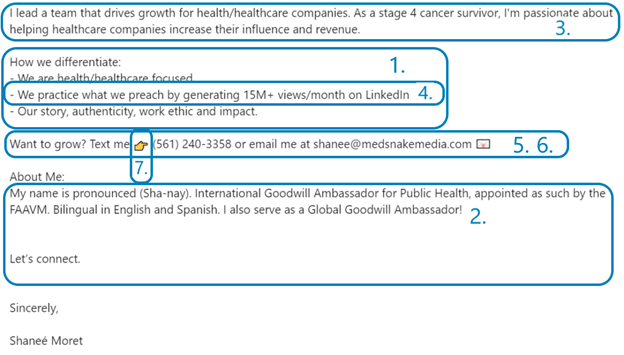
4. Value Everywhere You Turn
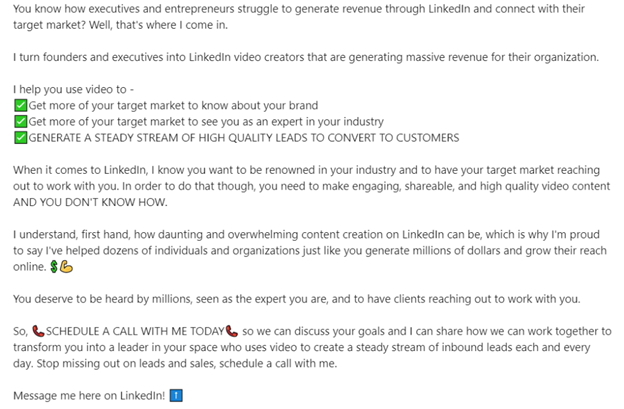
This summary provides an interesting example of how a great hook can be used in the intro, by asking a question. The pain points that are highlighted provide an excellent opportunity to target the reader and generate interest in reading further.
Each paragraph in the text is highlighted with a value, a pain point, or an empathetic statement. You can use this combination as inspiration for your creative process because it produces excellent results in practice.
Steps and Tips Applied:
- Hook statement in the form of a question;
- Included keyword;
- Summary is written in the first person;
- Prospects are offered value;
- CTA is included;
- Emojis were used as bullet points.
- Text divided into small paragraphs for easier reading;
- Solutions to common problems are demonstrated while focusing on the prospects’ major pain points.
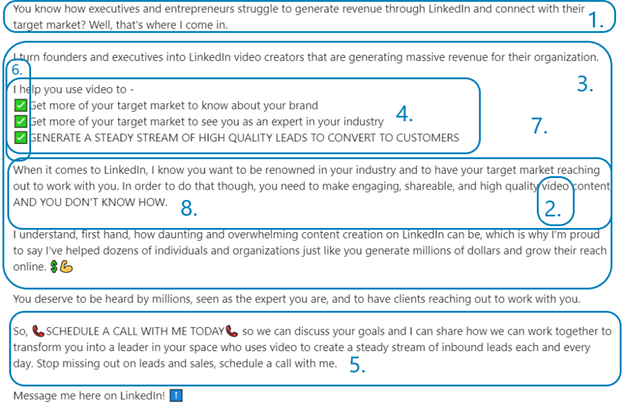
5. Quick Tips and 5 Steps Applied

This summary is well organized and follows the structure: it is a straight-to-the-point example.
Furthermore, the author capitalized on many verbs and directed the prospects’ eyes, creating a sense of action.
Another plus is that he uses simple language and gives the impression that he is already a member of the team.
Overall, this is an amazing LinkedIn summary for someone looking to become a sales professional.
Steps and Tips Applied:
- The structure is followed;
- Keywords are included.
- Summary is written in the first person;
- Prospects are offered value;
- Contact information is included;
- CTA is included.
- Text divided into small paragraphs
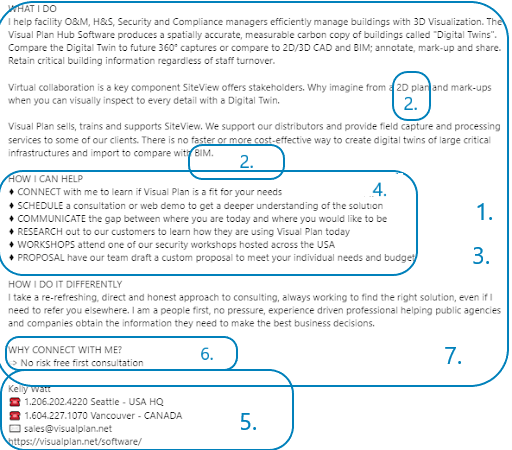
Conclusion
A well-written LinkedIn summary should persuade your prospects to accept your invitation and eventually convert. Using any of these Linkedin Summary examples for sales will accomplish this, so we hope it ignites lots of new ideas for your own.
Consider how you want to present yourself on LinkedIn, as the summary reflects your personal brand. But remember, as a salesperson, representing your company is even more important.
Write an excellent LinkedIn Summary by following the steps below:
- Make your readers hit “see more”
- Tell us who you are and provide your main goals
- Share what inspires you and explain why
- Give brief information about your job experience and describe your accomplishments
- Educate your prospects on how your product/service can help them reach their goal
Don’t forget to use the tips we’ve provided, they’ll work best when combined with the Steps above.
- Start writing your summary in the first-person point of view, and don’t be afraid to inject some character.
- To improve your LinkedIn ranking, add keywords that are relevant to your industry.
- Describe your professional background and pinnacle achievements. Focus on the pain points of the prospect, and list the typical problems you have solved. Describe the prospects and their goals in your summary. And provide facts, awards, and/or metrics about your accomplishments.
- Organize the content into brief paragraphs and bullet points, highlight text with bold or italics, use emojis, and include your contact information and a CTA at the end.
So there you have it, five simple steps to follow for a standout LinkedIn profile that will help boost your sales prospecting. Of course, if all of this sounds like too much work (or you just don’t have the time), our team at Demand.Cloud can take care of it for you.
We offer a LinkedIn optimization service that will make sure your profile is as effective as possible in generating leads. Get a Demo today!
